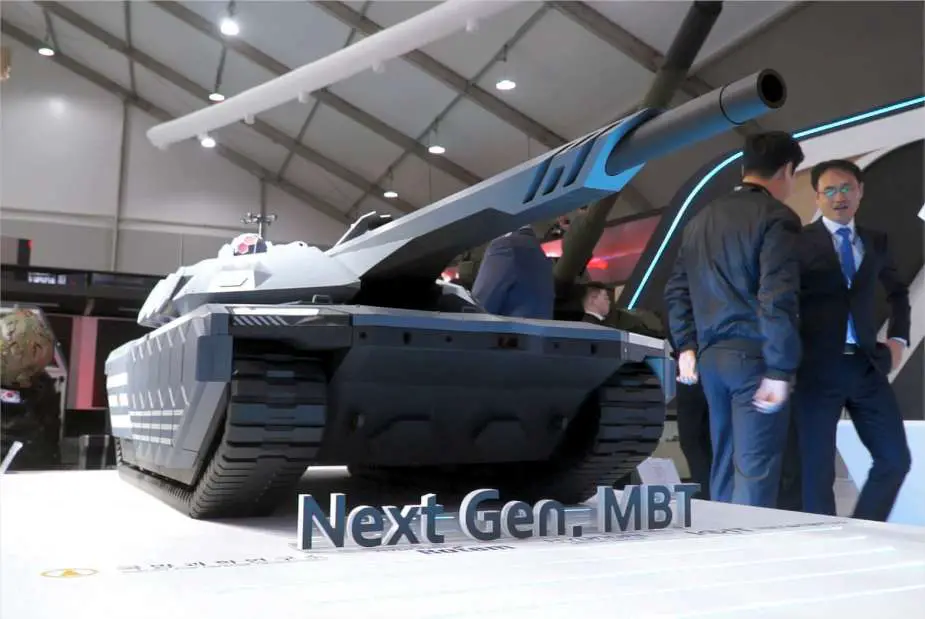Breaking news
South Korea's 2030s NG-MBT Main Battle Tank promises advanced capabilities.
According to Sunshine on November 23, 2023, the South Korean defense industry recently showcased the design concept for the Next-Generation Main Battle Tank (NG-MBT), already referred to as K3 by some observers. This tank is a response to the South Korean Army's assessment that the current K2 Black Panther MBT no longer adequately addresses the tactical demands of modern combat scenarios.
Follow Army Recognition on Google News at this link

Hyundai Rotem recently showcased a scale model of the NG-MBT at the ADEX 2023 exhibition. (Picture source: Army Recognition)
The Joint Chiefs of Staff of the South Korean Army have given their approval for the development of the NG-MBT, with the first prototype anticipated for release in 2030. This Next-Generation Main Battle Tank is slated for deployment in the 2030s and is expected to bring improvements in firepower, protection, and mobility for the Republic of Korea Army.
The NG-MBT design follows a traditional layout, featuring a driver's compartment at the front, a turret in the middle, and a powerpack located at the rear. A distinctive feature is the unconventional crew placement, with all three crew members – the driver, commander, and gunner – housed in an armored capsule in the front section of the hull. This design aims to provide an additional layer of protection by isolating the crew from the automatic loader and ammunition storage.
Similar to the American AbramsX and the Russian T-14 Armata Main Battle Tanks, the NG-MBT features an unmanned turret armed with a remotely controlled 130mm smoothbore gun. This gun allows the tank to reach targets at a maximum range of 5 km and includes a fully automated loading system. Additionally, the tank is armed with at least two multi-purpose anti-tank guided missiles (ATGMs) with a maximum range of 8 km, possibly including a top attack mode for line-of-sight (LOS)/beyond line-of-sight (BLOS) attacks. The turret could also be equipped with a remote-controlled weapon station designed to be armed with weapons between 12.7 to 30mm, depending on user preferences.
In terms of defense capabilities, the NG-MBT includes a Directional Infrared Counter Measures (DIRCM) system, designed to disrupt enemy heat-seeking missiles. This is coupled with an Active Protection System (APS) and a drone jamming device, providing an extra layer of defense against incoming threats.
A notable aspect of the NG-MBT is its low-profile design, reminiscent of the Polish PL-01 tank, coupled with reduced radar and infrared visibility, making the tank challenging to detect by enemy forces. Interestingly, the tank's anti-tank missile system features stealth capabilities due to its integration within the turret. To maximize survivability, the NG-MBT utilizes various stealth technologies, including a metamaterial-based RF and infrared stealth camouflage structure and a lightweight, rigid stealth structure responsive to multiple bands (infrared, radar, and millimeter waves).
Armor protection is a crucial consideration in the NG-MBT design, with the tank being equipped with the latest generation of modular armor systems composed of steel, ceramics, and composite materials. This includes passive armor such as ultra-high-hardness armor plates (UHA) and non-oxide ceramic armor materials arranged in a multi-layer structure. The tank turret armor module is made of inert reactive armor (NERA) capable of protecting against large-diameter kinetic energy penetrator (KEP) and chemical energy penetrator (CEP) projectiles.
Additionally, removable reactive armor (ERA) modules are installed on the sides and in the upper part of the tank, and lower armor and a mine protection kit were developed in accordance with the STANAG 4569 level 4a/4b standard (protection against TNT mines 10 kg).
Regarding mobility, the NG-MBT is believed to have a crew comprised of between 2 and 3 members, a combat weight of less than 55 tons, and dimensions of less than 10.8 m long, 3.6 m wide, and 2.4 m high. The tank is equipped with rubber tracks to reduce mobility noises, and a Diesel engine enables a maximum road speed of 70 km/h and 50 km/h off-road. The tank is said to offer a substantial cruising range of up to 500 km.
In terms of technology, the tank is believed to include a combat system using AI algorithms to provide 360° situational awareness, a manned & unmanned combined system, a multi-purpose drone included in a situational awareness system, a satellite communication antenna, and a CSISR (Command, Control, Communication, Computer, Cyber Information, Surveillance, and Reconnaissance) system featuring a high-speed communication system.
The intelligent fire control system of the next-generation tank aims to determine optimal tactics for battles in future battlefield environments, maximizing combat effectiveness and survivability by assigning missions to each tank. Development participating companies, including the Agency for Defense Development, Hyundai WIA, Poongsan, and Hyundai Rotem, are collaboratively working on this project, and various core technology research and development for the Next Gen MBT project are currently underway. This includes autonomous driving sensors and selective unmanned operation when necessary, illustrating a comprehensive and forward-looking approach to South Korea's defense capabilities on the modern battlefield.























